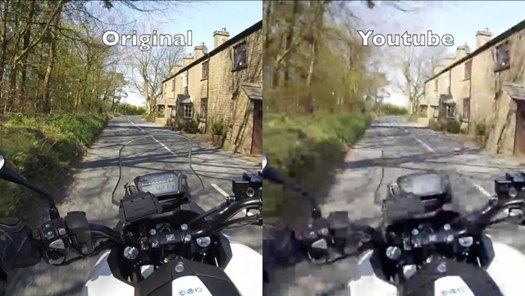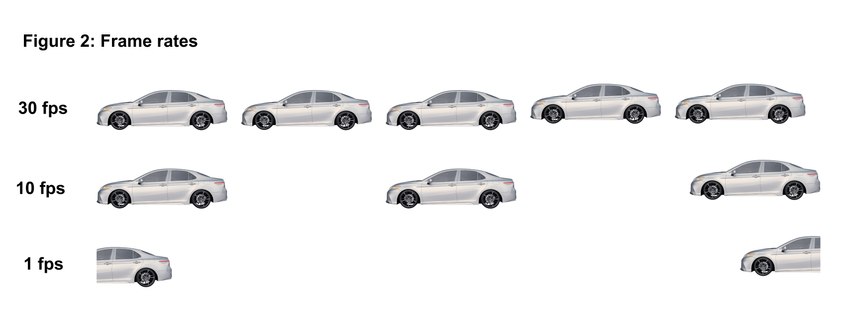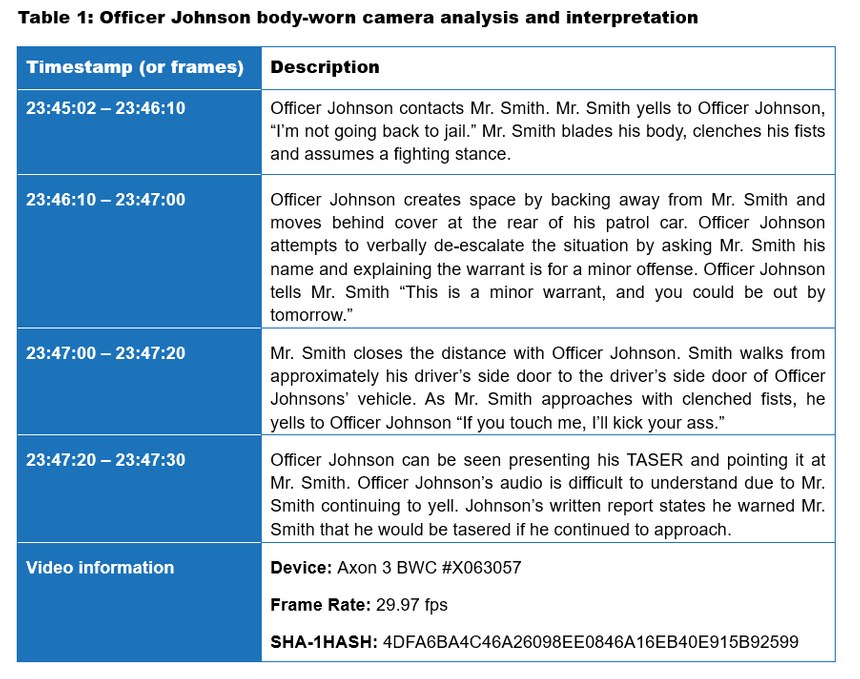By David Blake, Ph.D., and Robert “Bob” McFarlane
“Video’s probative value rests primarily in the perceptual experiences of its perceivers. Thus, to begin developing an evidence-based method for analyzing the probative value of video evidence, we must investigate the potential for error inherent in perceivers’ viewing and interpretations of video, as well as the extent of their awareness of any such errors.” — Granot et al., In the eyes of the law: Perception versus reality in appraisals of video evidence
Earlier this year, a police officer was facing manslaughter charges with a maximum prison term of 20 years. The involved officer had pursued a suspected drunk driver and – at the termination point – approached the passenger side of the vehicle with his weapon drawn. The suspect was non-compliant and attempted to flee, resulting in the officer opening the passenger door and ordering the suspect to hand over his keys.
Appearing to comply, the suspect leaned into the passenger seat and, with his right hand, reached toward the officer to pass him the ignition key. The key was attached to a 37” long shoestring lanyard tied in a circle at the ends. The officer grabbed the key with his left hand while maintaining a retention position with his handgun. Unexpectedly, the suspect pulled back on the lanyard, and a short tug-of-war ensued. During the struggle over the lanyard, the officer’s firearm discharged striking the suspect in the head. The officer stated that he did not pull the trigger intentionally and did not know what caused the weapon to discharge.
The incident was captured on the officer’s body-worn camera (BWC). Motion blur, low light and changing angles created a video recording that was difficult to interpret. The lead criminal investigator – who had no training or experience in working with digital video evidence or investigating officer-involved shootings – did not have an in-house ability to conduct a frame-by-frame analysis of the video. The video was sent to the state’s forensic laboratory for enhancement and was ultimately sent back in the form of individual frames but included no analysis or interpretation of the video’s content. The untrained investigator performed his own analysis and concluded the officer’s finger was on the trigger during the entire incident, resulting in a negligent discharge. The prosecutor’s office accepted this assessment and filed charges of involuntary manslaughter.
The officer’s defense counsel retained both authors of this article with Mr. McFarlane’s forensic video analysis and testimony significantly impacting the outcome. At trial, Mr. McFarlane presented individual frames from the video showing the officer’s finger was indexed at various times leading up to the shooting and that the trigger guard was clear a little over a second prior to the pistol discharging. The strongest impact came from Mr. McFarlane’s presentation of individual frames showing the suspect’s left hand, in a swiping motion, coming into contact with the officer’s firearm a split-second before the gun discharged. This evidence was likely a compelling factor as the jury returned a not-guilty verdict in about an hour.
We believe the charges in this case were founded on a faulty interpretation and analysis of the video evidence. The intent of this article is to hopefully prevent a similar situation from occurring in the future.
Understanding digital media evidence
Historically, video recordings consisted of a series of photographs strung together on film. Each photograph was a true capture of the visual scene and remained in its original form when projected upon a screen. Advancements in technology changed that, relegating hard-copy images to the past. Instead, digital video exists electronically as a series of ones and zeroes that rely upon complex algorithms to encode, decode and present visual information. The digital video algorithms determine the quality of video evidence. The following narrative introduces two factors (compression and frame rates) that can influence the quality of visual information contained in a digital video recording.
Compression: Digital recording devices almost always compress video, both spatially (within each frame) and temporally (between the frames) to save memory storage space.
With temporal compression, an encoding device will attempt to predict change from one frame to the next. Visual data determined to be unchanging within a series of frames is not re-recorded but simply reproduced from other frames (see I-P-B Frames).
Think of video compression as eliminating redundancies and focusing on saving new information over a period of time. The amount of compression directly influences the quality of the video and may result in some information not being captured or presented with insufficient detail to accurately determine what took place. Compression “artifacts” can cause visual information to be degraded/distorted in ways that impact visual interpretation. Figure 1 shows an example of compression artifacts.

Figure 1. Compression (Source: https://www.youtube.com/watch?v=tdEDnywSExI (permission granted by author))
Frame rates: The frame rate determines how many individual still images are captured over a period of time, usually within each second. Reduced frame rates can be a method for reducing file size, but can also significantly reduce the amount of visual information captured, affecting the appearance of movement. For instance, a surveillance camera capturing 1 to 5 frames per second will not provide a smooth visual flow of action, may not capture important split-second information (i.e., a punch), and may result in a skewed interpretation of movement (Frame Rate).

Recommendations for collecting, handling and analyzing digital video evidence
Today’s digital video evidence generally consists of recordings from BWCs, surveillance cameras and cellular phones. These sources of digital video are a valuable resource for investigating crimes, use of force by police, and other forms of misconduct or human error. Unfortunately, many officers and investigators may not receive training on collecting, handling, or analyzing digital video evidence. This lack of knowledge can lead to legal challenges regarding the validity and authenticity of the evidence as well as improper interpretations of digitally produced visual information.
Therefore, the collection of digital media evidence (DME) should minimally include information about the capture device and its settings as well as the location of the camera(s) and detailed information on how the evidence was collected. Due to most of today’s DME existing in a digital format that can be easily altered, methods for ensuring the integrity of the original recording or verifying a direct original copy is a must.
The Law Enforcement and Emergency Services Video Association International (LEVA) recommends the following steps:
1. Verify the integrity
Integrity verification is a process of confirming that the data presented is complete and unaltered since the acquisition. Essentially, we want to know that we are working with the original unaltered video. This can be accomplished by assigning the newly acquired video file a HASH value. A HASH value is a unique identifier assigned via an algorithm. A comparison of HASH values between two versions of video evidence will show a difference if even one pixel has been changed. However, in some cases, determining whether a video has been altered may require expert assistance. A free and easy-to-use HASH application (e.g., QuickHash) is available online.
2. Authentication
Like any other evidence, video and audio evidence must be shown to be a fair and accurate representation of what someone purports it to prove. For example, does a video recording accurately show what occurred in front of the camera? Does compression, aspect ratio, the frame rate, or other factors limit the evidentiary value of the video? Officers and investigators should have some idea of what they are working with to ensure they accurately interpret the video. There is also free and easy-to-use software available, such as MediaInfo, that can assist in identifying such information about a video.
3. Analysis and interpretation
The perceived evidentiary strength of digital media evidence is founded on the belief that such evidence provides an objective and unbiased representation of reality. Some common statements often associated with video evidence include: “The BWC provides the perspective of the officer,” “The video evidence speaks for itself,” and, “The video doesn’t lie.” The reality is that a BWC video provides a visual perspective from the officer’s location but doesn’t capture the full perspective or perception of the officer. Also, video cannot “speak,” and the truth may be limited by the inherent capabilities of the recording device(s) as well as the subjective and potentially error-prone interpretation of viewers. This is well-known in Hollywood as films and television shows use techniques to manipulate the attention and perception of viewers (see: Lights, Camera, Perception: How Movies Mold your Mind).
When conducting reviews of use-of-force videos, the investigator should consider the impact of “perspective bias,” i.e., the perspective and perception experienced when watching a video of an incident may be significantly different than the perspective of the involved parties. Also, human limitations associated with visual attention and working memory can result in the actual participants experiencing perceptual failures to see, i.e., inattentional blindness or change blindness. Such perceptual failures can also be experienced by investigators or other viewers of video.
Due to human limitations and the potential to miss or misinterpret visual information, consider viewing the video at both full speed and frame by frame while using a quadrant approach. For example, focusing on the upper right-hand corner of the video screen while moving forward and backward through frames can assist in identifying items or movements that may be missed at full-speed playback. After a thorough review of one quadrant is complete, the process should be repeated in the other quadrants. The quadrant review process may take a significant amount of time, but considering the high stakes associated with use-of-force investigations, a failure to competently and thoroughly review the video evidence borders upon investigatory negligence.
Many detectives or administrators who may be involved in the interpretation or analysis of force-related video evidence are not experts on the use of force. Therefore, we suggest a subject matter expert be allowed to assist investigators in identifying critical aspects of the video as well as compliance or divergence from trained tactics/techniques.
In some cases, a camera may not capture all the information reported by a citizen or an officer. Examples are often found in ground fights where the lens of the camera is obstructed for several seconds. A punch, a kick, or even the retrieval/dropping of a firearm can occur in less than 250 milliseconds. If the camera lens is obscured or the frame rate is extremely low, the recording may not show these actions or may not show them accurately.
Officers and investigators should be aware that divergence between what an officer or citizen reported as occurring – but not recorded on the video – is not de facto evidence of deceit. We suggest officers identify where their perceptions/memory diverge from the video. Subsequently, investigators should attempt to rectify the differences or accurately report obstructions or image blur that may be the cause for the differences.
Lastly, we often hear that agencies are not capable of reviewing video footage frame by frame. Never fear! A solution in the form of free or inexpensive software providing this capability is available (see SMPLAYER).
4. Video work product
If possible, investigators should consider including video work products within their investigatory files. This may be provided internally by trained personnel or externally by crime laboratories or forensic video experts. Minimally, the video should be encoded with frame numbers for accurate reference. Additional work products may include individual sequences of the video, slow-motion video, enlargement, and frame extractions. We urge caution when enhancing video, since increasing only the brightness in videos captured at night may misrepresent the visibility of items at the time of recording.
5. Reporting video/audio evidence
Officers and investigators should take a structured approach to reporting the audio-visual information from digital media. We suggest minimally reporting the information about the recording device and camera, the methods used to capture the data, a HASH of the original video, and background information about the video, such as the resolution, frame rate and duration.
When reporting on the analysis and interpretation of the content of the video, we suggest a structured method such as that presented in Table 1. Table 1 is an example of a chronology of events and should include timestamps or frame numbers (preferred when available) and a corresponding description of the audio and visual information.
One important issue to remember when reporting an analytic chronology of events is the related frame rate. For example, we often see the embedded timer (i.e., 23:07:35) used as a reference when stopping a video to discuss a point of interest. It is important to remember that 30 or more individual images (frames) may exist within a second. The point of interest may change drastically over the course of a few frames, but still be within the same second on the embedded timer. This is why the investigator should note the specific frame number of the video when referring to a still image or series of images.

Summary
In our experience, digital media evidence is not always collected, controlled, or analyzed consistently with traditional physical evidence. Investigators would never recover a firearm without taking a photo and noting the make, model, serial number and caliber. If sent to the lab, the firearm would likely be tested for functionality and a documented chain of custody ensures evidentiary integrity. However, many agencies seem to treat digital video and audio evidence differently.
Stakeholders should be concerned with the handling and presentation of digital evidence due to its potential impact on civil and criminal litigation. Officers and investigators should be trained and guided by standards when collecting, transferring, and working with digital media evidence, as it is often viewed as powerful evidence.
There are many educational resources, such as the Scientific Working Group on Digital Evidence, and certifying and training organizations such as the Law Enforcement and Emergency Services Video Association International (LEVA), that can help make sure your agency is presenting the best evidence to administrators, prosecutors and the courts. Failure to do so may have significant negative ramifications for and your organization.
Special thanks to Jeff Martin, JD, CFVT (DSI Consulting) and Jamie Borden (Critical Incident Review) for peer-reviewing and editing this article.
About the authors
David Blake, Ph.D., is a retired California peace officer and a court-qualified expert on human factors psychology, video, and the use of force. Dave is a LEVA certified Forensic Video Technician and has significant experience teaching the use of force and human factors psychology to law enforcement officers across the country. Dave has undergraduate and graduate degrees in criminal justice and psychology with a research focus on police use of deadly force. He has authored over 40 professional and peer-reviewed journal articles on the application of human factors psychology to first responders and their operational environments. He owns Blake Consulting and Training and can be reached at Dave@Blake-Consulting.com
Robert “Bob” McFarlane is a forensic video analyst who has testified in state and federal courts across the country. Bob has 12 years of experience as an Oakland, California, police officer working assignments inclusive of patrol, street narcotics enforcement, vice narcotics, tactical team, and the beat health unit responsible for orchestrating civil actions against drug houses. Bob was an investigator with rains Lucia Stern St. Phalle & Silver, PC, specializing in complex matters, including serious criminal cases, high-profile disciplinary actions, and litigation support. Bob is a veteran of the United States Air Force. He can be reached at robert@mcfarlanefva.com.


